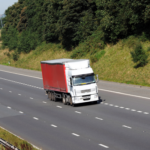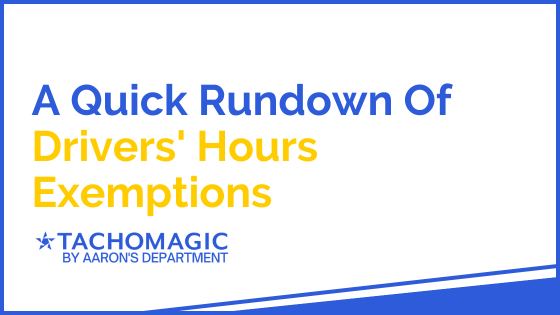A Quick Rundown Of Drivers' Hours Exemptions
There are a number of exemptions from the EU Drivers' Hours tachograph laws, and only have to follow GB domestic laws (the Working Time Directive). In order to be compliant with the WTD, a tachograph is still required, but the rules aren't as strict.
We've abbreviated the official government guidance to make it easier to check whether your vehicles are exempt. Naturally, we've had to cut some extra detail & guidance to do this! If you spot an exemption on our page you think might apply, we'd recommend double-checking it on the gov.uk website (we'll provide a link to the relevant pages where necessary).
Table of Contents

HGV Drivers' Hours Exemptions: EU Rules
The following HGVs are exempt from EU Drivers' Hours rules across the EU, and need only adhere to GB domestic law when in the UK. 'GB domestic law' does not strictly require a tachograph, but you may still find it useful to help record driver hours.
To get more detail on a specific exemption, visit the gov.uk HGV rules page.
| HGV EU Rules Exemptions |
|---|
| - Vehicles incapable of exceeding 40km/h, or limited to below 40km/h. |
| - Vehicles owned, rented, or commandeered by the armed forces or the emergency services - this only applies when the vehicle is being operated by those groups. |
| - Vehicles used in emergencies or rescue operations. - The rules do not define what an "emergency" constitutes, but any risk to the health of people or animals, any serious disruption of essential public services, or serious damage to property would probably be considered "emergencies". |
| - Vehicles delivering non-commercial humanitarian aid, used in emergencies or rescue operations. |
| - Vehicles undergoing road tests, and new or rebuilt vehicles, which have not yet been put into service. |
| - Vehicles or combinations of vehicles with a maximum permissible mass lower than 7.5 tonnes used for the non-commercial carriage of goods. For example, vehicles used for moving house, or for leisure pursuits such as transporting a boat. |
| - Specialised vehicles used for medical purposes. |
| - Specialised breakdown vehicles operating within a 100km radius of their base. |
| - Historic (over 25 years old) vehicles used for non-commercial purposes. |
| - Vehicles or combinations of vehicles with a maximum permissible mass not exceeding 7.5 tonnes, used for carrying materials or equipment for the driver’s use in the course of their work, or delivering hand-made items produced on a small scale. The vehicle must operate within a 100km radius of its base, driving the vehicle must not be the driver's primary activity, and the vehicle must not be driven for hire or reward. |
HGV Drivers' Hours Exemptions: National Derogations
If the following conditions are met, the vehicle will be exempt from EU Drivers' Hours rules, and need only adhere to GB domestic law. 'GB domestic law' does not strictly require a tachograph, but you may still find it useful to help record driver hours.
However, the following exemptions only apply in the UK - if your vehicle will leave the UK at any point in your journey, a tachograph will be legally required.
To get more detail on a specific exemption, visit the gov.uk HGV rules page.
| HGV National Derogations |
|---|
| - Vehicles owned or hired by public authorities, which won't compete with private transport enterprises. For a list of examples, click here. |
| - Vehicles used or hired without a driver by agricultural, horticultural, forestry, farming, or fishery undertakings for carrying goods as part of their own entrepreneurial activity within a 100km radius of the base of the undertaking. |
| - Tractors used for agricultural or forestry activities within a 100km radius from the base of the undertaking that owns, hires or leases the tractor. |
| - Vehicles used to carry live animals between farms, markets, and slaughterhouses, where the distance between the start and end destinations is less than 100kms. |
| - Vehicles being used to carry animal waste or carcasses that are not intended for human consumption. |
| - Specially fitted mobile project vehicles, such as play buses, mobile libraries, mobile classrooms. These vehicles must primarily be for use as an educational facility when stationary. |
| - Vehicles used by "universal service providers" operating within 100km of their base, provided that driving is not considered to be the driver's primary activity. As of 2024, the Royal Mail is the UK's only universal service provider. |
| - Vehicles that operate exclusively on islands up to 2300 square kilometres in size, not linked by any bridges, tunnels, causeways, etc. |
| - Vehicles used for the carriage of goods within a 100 km radius from the base of the undertaking and propelled by means of natural or liquefied gas or electricity. The maximum permissible mass of the vehicle (including any trailers) must not exceed 7.5 tonnes. |
| - Driving instructors' vehicles, provided they are not being used for the transportation of goods or passengers. |
| - Sewerage, flood protection, water, gas and electricity maintenance services. The vehicles must be used for the maintenance of an existing service, rather than the construction of new infrastructure. |
| - Door-to-door household refuse collection or disposal. This derogation is subject to extra conditions, which you can read here. |
| - Vehicles used in connection with road maintenance services which are engaged on a journey directly relating to the maintenance services, (for example, removing rubble) or are being used directly on the maintenance activity (for example, laying tarmac). This derogation doesn't apply to the same vehicles when they are travelling to or from the location of their activities. |
| - Vehicles specifically used to carry out broadcasting or streaming. |
| - Specialised vehicles carrying funfair/circus equipment. This exemption is subject to extensive 'small-print', so we recommend you check the gov.uk website if this might apply to your vehicles. |
| - Vehicles used for milk collection from farms, returning milk containers to farms, or delivering milk products intended for animal feed to farms. |
| - Vehicles used exclusively within ports, rail hubs, airports, and other similar locations. These vehicles may occasionally leave the site for maintenance purposes. |
| - Any vehicle used by the RNLI. |
| - Any vehicle manufactured before 1947. |
| - Any vehicle propelled by steam. |
Concession for members of a volunteer force and instructors in the Cadet Corps.
Drivers who are in the cadet corps or are army reservists can follow a more lenient set of the EU Drivers' Hours rules, giving them more flexibility. If this applies to you or any of your drivers, click here to read the full list of concessions.

PSV Drivers' Hours Exemptions: EU Rules
In the following circumstances, PSVs are exempt from EU Drivers' Hours rules across the EU, and need only adhere to GB domestic law when in the UK.
'GB domestic law' does not strictly require a tachograph, but you may still find it useful to help record driver hours.
To get more detail on a specific exemption, visit the gov.uk PSV rules page.
| PSV EU Rules Exemptions |
|---|
| - Vehicles used for the carriage of passengers on regular services with a route that does not exceed 50km. The frequency of the service must be regular/timetables, and the route predetermined. There must be at least one predetermined stop (not including the start/end destinations) where passengers can (dis)embark. - The 50km limit applies to the extent of the route, and does not include any back-and-forth along the route. |
| - Vehicles incapable of exceeding 40kmph, including speed limiters. |
| - Vehicles owned, rented, or commandeered by the armed forces or the emergency services - this only applies when the vehicle is being operated by those groups. |
| - Vehicles undergoing road tests, and new or rebuilt vehicles, which have not yet been put into service. |
| - Vehicles used in emergencies or rescue operations. - The rules do not define what an "emergency" constitutes, but any risk to the health of people or animals, any serious disruption of essential public services, or serious damage to property would probably be considered "emergencies". |
| - Specialised vehicles used for medical purposes. |
| - Historic (over 25 years old) vehicles used for non-commercial purposes. |
PSV Drivers' Hours Exemptions: National Derogations
If any of the following conditions are met, the vehicle will be exempt from EU Drivers' Hours rules, and need only adhere to GB domestic law. 'GB domestic law' does not strictly require a tachograph, but you may still find it useful to help record driver hours.
However, the following exemptions only apply in the UK - if the vehicle will leave the UK at any point on a journey, a tachograph is legally required.
To get more detail on a specific exemption, visit the gov.uk PSV rules page.
| PSV National Derogations |
|---|
| - Vehicles with between 10 and 17 seats used exclusively for the non-commercial carriage of passengers. The "exclusivity" applies to the operator of the vehicle. For example, a vehicle hired for a one-off non-commercial occasion would be exempt, even if it has carried out commercial carriage in the service of other operators. - Commercial vehicles that have been borrowed by an employee for a non-commercial occasion are not exempt. |
| - Vehicles owned or hired by public authorities, which won't compete with private transport enterprises. For a list of examples, click here. |
| - Vehicles that operate exclusively on islands up to 2300 square kilometres in size, not linked by any bridges, tunnels, causeways, etc. |
| - Driving instructors' vehicles, provided they are not being used for the transportation of goods or passengers. |
| - Vehicles used exclusively within ports, rail hubs, airports, and other similar locations. These vehicles may occasionally leave the site for maintenance purposes. |
| - Specially fitted mobile project vehicles, such as play buses, mobile libraries, mobile classrooms. These vehicles must primarily be for use as an educational facility when stationary. |
| - Any vehicle used by the RNLI. |
| - Any vehicle manufactured before 1947. |
| - Any vehicle propelled by steam. |
Concession for members of a volunteer force and instructors in the Cadet Corps.
Drivers who are in the cadet corps or are army reservists can follow a more lenient set of the EU Drivers' Hours rules, giving them more flexibility. If this applies to you or any of your drivers, click here to read the full list of concessions.
Drivers' Hours Exemptions: Summary
In summary, a range of vehicles, uses and organisations are exempt from EU Drivers' Hours laws.
The government's official list is a tricky read because they go into a lot of detail. We've simplified things here so you can easily spot exemptions which might apply to you, but we always recommend checking the gov.uk website if you find any!

About TachoMagic
TachoMagic is a tachograph analysis bureau that's been in the business for decades. Our quick, effective, and easy-to-use tachograph reports are used by thousands of businesses across the UK, saving them time and money.
We are also a supplier of automatic download devices - these plug & play pieces of kit will ensure that you never have to manually download Driver or vehicle data again. It's automatically done, remotely, whenever the vehicle is in motion. Interested? Use the buttons below to find out more, or feel free to get in touch.
Further Reading
If you've found our post, "A Quick Rundown Of Drivers' Hours Exemptions" useful, you might also be interested in:
- Tachograph rules for vans and trailers
- Do you need a tachograph for private use?
- What is the fine for driving without a tacho card?
About The Author

Simon Theaker
Simon has over 20 years of dealing with tachograph analysis, and the technologies involved.
His in-depth knowledge and hands-on experience have made him a key behind-the-scenes member of the TachoMagic team.
Through his blogs, Simon hopes to make the lives of Fleet Managers easier, as he shares the answers to some of the most common questions he has received.

